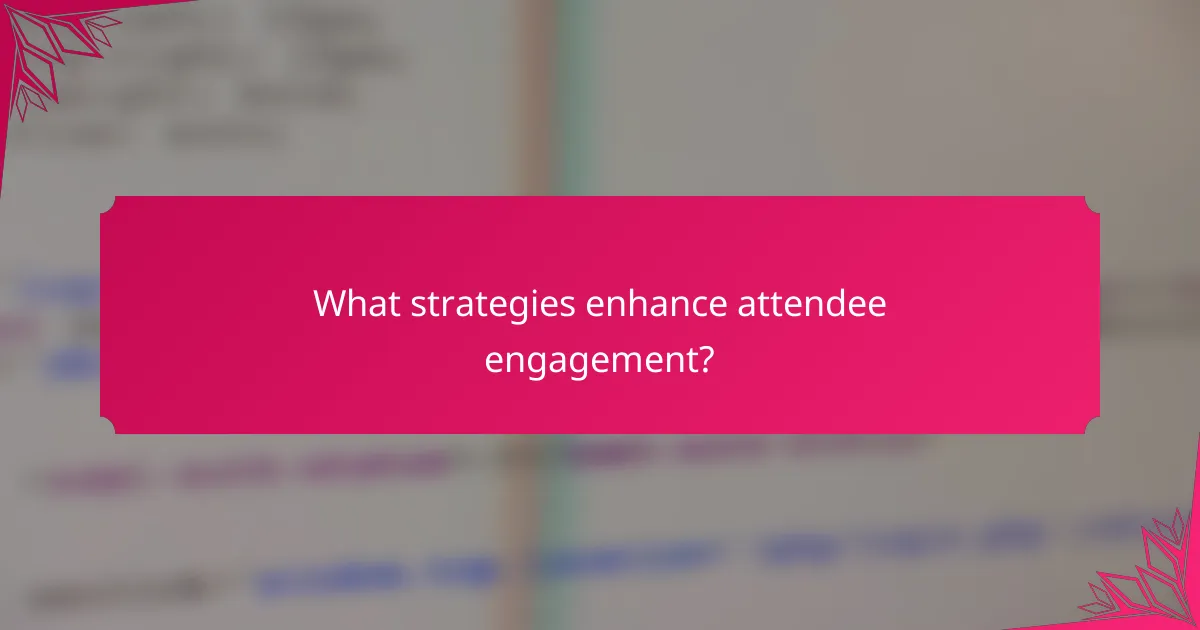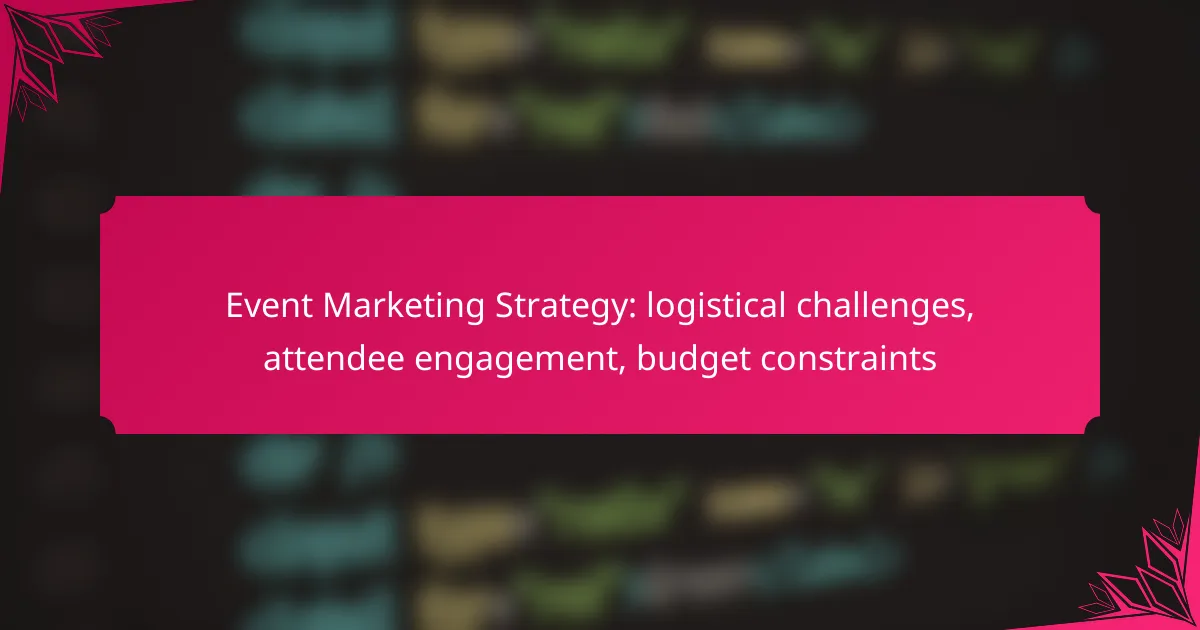Event marketing strategies must navigate logistical challenges, enhance attendee engagement, and manage budget constraints effectively. Meticulous planning and technology utilization can streamline operations, while interactive experiences foster deeper connections with participants. Additionally, strategic budgeting and resource allocation are essential to ensure that events remain impactful without exceeding financial limits.

How to overcome logistical challenges in event marketing?
To overcome logistical challenges in event marketing, it is crucial to plan meticulously and leverage technology. Effective organization, clear communication, and strong vendor relationships can significantly enhance the execution of your event.
Utilize event management software
Event management software streamlines the planning process by centralizing tasks such as registration, scheduling, and budgeting. Tools like Eventbrite or Cvent can help manage attendee lists, ticket sales, and even marketing efforts, reducing manual errors and saving time.
When selecting software, consider features that align with your specific needs, such as mobile accessibility or integration with other tools. A good platform can enhance attendee experience and simplify post-event analysis.
Implement a detailed project timeline
A detailed project timeline is essential for tracking progress and ensuring all tasks are completed on schedule. Break down the event planning process into phases, assigning deadlines and responsibilities to team members.
Use project management tools like Trello or Asana to visualize your timeline and monitor milestones. Regularly review and adjust the timeline as needed to accommodate any unexpected changes or challenges.
Coordinate with local vendors
Building strong relationships with local vendors can alleviate many logistical hurdles. Engage caterers, audio-visual providers, and transportation services early to secure their availability and negotiate favorable terms.
Consider creating a vendor checklist that includes contact information, services provided, and deadlines for deliverables. This ensures that all parties are aligned and reduces the risk of last-minute surprises.
Conduct site visits
Conducting site visits allows you to assess the venue’s suitability and identify potential logistical issues. Familiarize yourself with the layout, access points, and facilities to ensure they meet your event’s needs.
During the visit, take notes on critical aspects such as power sources, Wi-Fi availability, and emergency exits. This information will help you plan more effectively and address any concerns before the event day.
Establish clear communication channels
Clear communication channels are vital for coordinating efforts among team members, vendors, and attendees. Use tools like Slack or Microsoft Teams to facilitate real-time communication and share updates efficiently.
Set expectations for response times and establish a protocol for escalating issues. Regular check-ins can help ensure everyone is on the same page and can quickly address any logistical challenges that arise.

What strategies enhance attendee engagement?
Enhancing attendee engagement involves creating interactive and personalized experiences that resonate with participants. By leveraging technology and social media, event organizers can foster real-time connections and provide valuable content that keeps attendees invested.
Incorporate interactive technology
Using interactive technology can significantly boost attendee engagement. Tools like live polling, Q&A sessions, and augmented reality experiences allow participants to interact directly with the event content and each other.
Consider implementing event apps that facilitate networking, provide session feedback, and offer gamification elements. These features can encourage attendees to participate actively rather than passively consume information.
Offer personalized experiences
Personalization can greatly enhance the attendee experience by tailoring content and interactions to individual preferences. Collecting data through registration forms or pre-event surveys helps identify topics of interest and preferred networking opportunities.
For example, creating customized agendas or suggesting sessions based on attendee profiles can make participants feel valued and more connected to the event. This approach often leads to higher satisfaction and retention rates.
Utilize social media for real-time interaction
Social media platforms are powerful tools for fostering real-time interaction during events. Creating dedicated event hashtags encourages attendees to share their experiences, insights, and photos, enhancing the sense of community.
Live streaming key sessions and encouraging online discussions can also engage both in-person and virtual attendees. Regularly updating social media feeds with highlights and engaging content keeps the conversation going even after the event concludes.
Provide engaging content and speakers
High-quality content and compelling speakers are crucial for maintaining attendee interest. Selecting speakers who are not only knowledgeable but also engaging can make sessions more dynamic and enjoyable.
Incorporating diverse formats, such as panels, workshops, and interactive discussions, can cater to different learning styles and preferences. Ensuring that content is relevant and actionable will keep attendees engaged and eager to participate.

How to manage budget constraints in event marketing?
Managing budget constraints in event marketing involves careful planning and strategic decision-making to maximize resources. Focus on prioritizing essential expenses, seeking sponsorships, negotiating with vendors, and utilizing cost-effective marketing channels to stay within budget while achieving your event goals.
Prioritize essential expenses
Identifying and prioritizing essential expenses is crucial for effective budget management. Start by listing all potential costs and categorizing them into must-haves and nice-to-haves. Allocate funds first to critical elements such as venue rental, catering, and technology, while considering trimming non-essential items.
For example, if your event relies heavily on audio-visual equipment, ensure that budget allocation reflects this priority. This approach helps to avoid overspending on less impactful areas, ensuring that the core components of your event are well-funded.
Seek sponsorship opportunities
Sponsorships can significantly alleviate budget constraints by providing additional funding or in-kind contributions. Approach businesses that align with your event’s theme or target audience, and offer them visibility in exchange for their support. This could include logo placement, speaking opportunities, or promotional materials.
Consider creating tiered sponsorship packages to attract different levels of investment. For instance, a gold sponsor might receive premium benefits, while a silver sponsor could enjoy more limited exposure. This flexibility can help secure a broader range of sponsors.
Negotiate with vendors
Negotiating with vendors can lead to substantial cost savings. When approaching suppliers, be transparent about your budget constraints and explore options for discounts or bundled services. Many vendors are willing to negotiate, especially if they see potential for future business or referrals.
For instance, if you are booking a catering service, ask if they can provide a reduced rate for a smaller menu or fewer courses. Building a good relationship with vendors can also lead to better deals in the long run.
Utilize cost-effective marketing channels
Cost-effective marketing channels can help promote your event without straining your budget. Leverage social media platforms, email marketing, and community partnerships to reach your audience at minimal costs. These channels often provide high engagement rates and can be tailored to specific demographics.
For example, using Facebook events or Instagram stories can generate buzz without significant expenditure. Additionally, consider collaborating with local influencers or organizations to expand your reach organically, which can be a powerful way to attract attendees without hefty advertising fees.

What are the prerequisites for a successful event marketing strategy?
A successful event marketing strategy requires clear objectives, a defined target audience, and a comprehensive budget. These elements are essential for guiding the planning process and ensuring that the event meets its goals effectively.
Define clear objectives
Clear objectives serve as the foundation of your event marketing strategy. They should be specific, measurable, achievable, relevant, and time-bound (SMART). For example, an objective might be to increase brand awareness by 30% within six months following the event.
Consider what you want to achieve with your event. Objectives can range from generating leads and boosting sales to enhancing customer loyalty or launching a new product. Clearly defined goals help in measuring success and making necessary adjustments.
Identify target audience
Understanding your target audience is crucial for tailoring your marketing efforts. Identify demographics such as age, gender, location, and interests to create a profile of your ideal attendees. This information will guide your promotional strategies and messaging.
Engage with your audience through surveys or social media to gather insights about their preferences. Knowing what appeals to them can enhance engagement and increase attendance. For instance, if your target audience prefers online events, consider virtual formats to maximize participation.
Establish a comprehensive budget
A comprehensive budget is vital for managing costs and ensuring financial viability. Start by listing all potential expenses, including venue rental, catering, marketing, and technology. Allocate funds based on priority and expected returns.
Be prepared for unexpected costs by including a contingency fund, typically around 10-15% of your total budget. Regularly review your budget against actual spending to stay on track and make adjustments as needed. This proactive approach helps avoid financial pitfalls and ensures the event remains profitable.

How to evaluate the success of an event marketing strategy?
Evaluating the success of an event marketing strategy involves measuring key performance indicators (KPIs) such as attendee satisfaction, engagement levels, and return on investment (ROI). By analyzing these metrics, organizers can determine what worked well and what needs improvement for future events.
Logistical challenges
Logistical challenges in event marketing can significantly impact the overall success of an event. Common issues include venue selection, transportation arrangements, and technology setup. Addressing these challenges requires careful planning and coordination to ensure a smooth experience for attendees.
To mitigate logistical challenges, create a detailed checklist that covers all aspects of the event, from vendor management to on-site registration. Regular communication with all stakeholders, including suppliers and staff, is crucial to avoid last-minute surprises.
Attendee engagement
Attendee engagement is critical for the success of any event marketing strategy. Engaging participants can lead to higher satisfaction rates and increased likelihood of future attendance. Techniques to enhance engagement include interactive sessions, networking opportunities, and personalized experiences.
Consider using technology such as event apps or live polling to facilitate interaction. Providing incentives, such as giveaways or exclusive content, can also motivate attendees to participate actively throughout the event.
Budget constraints
Budget constraints are a common concern in event marketing, affecting everything from venue choice to promotional efforts. To manage costs effectively, prioritize spending on elements that directly enhance attendee experience and event visibility.
Establish a clear budget framework that outlines essential expenses versus optional ones. Look for sponsorship opportunities or partnerships that can help offset costs. Regularly review expenditures against the budget to ensure financial goals are met without compromising quality.
